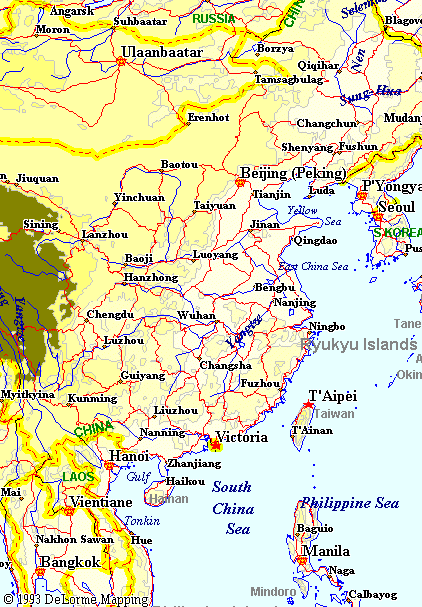Sino-Dutch Leonid Expedition 1998
1. INTRODUCTION
From early 1997 onward, plans started to be developed within the Dutch Meteor Society to organize an expedition to east Asia in order to observe the Leonid storm of 1998. Active members in the discussion are: Carl Johannink, Marc de Lignie, Marco Langbroek, Peter Bus, Robert Haas, Koen Miskotte, Jos Nijland and Casper ter Kuile. In this poster we will describe our efforts until now and our plans for the near future.
2. LOCATION
According to Yeomans {ref}, the 1998 storm will most likely occur near 19:45 UT on November 17. With this in mind, Carl Johannink and Casper ter Kuile have investigated possible locations suitable to observe the event. Primary criteria on which locations were judged were connected to a suitable observing window: amongst others the rise of the radiant and the start of twilight. Another important aspect is climatology. After gathering information for several regions and having compared these against each other we concluded that an observing location in central China would best fit our needs, other regions providing problems on the climatic or astronomical side of the issue. The upcoming 1997 apparition could possibly lead to some changes in prefered region if peak times show to be dramatically different, but currently China scores by far best on several selection criteria.

This graph shows the elevation of the Leonid radiant and the sun at various locations in China. The best observing window is between 18:00 UT and 21:30 UT.
3. GOALS OF THE EXPEDITION
This expedition will be a 'serious' expedition, aimed at gathering data of scientific value using visual, multistation photographic and video-observations and radio observations. Determining high accuracy photographic orbits of meteoroids and establishing influx-data with video- and visual techniques will be primary goals. Other observations considered are a.o. spectral photography. It is critical that photographic and video-observations be carried out from three locations about 50-100 kilometers apart. Visual and radio-observations could be done from one location, yet it is always better to spread the risk of bad weather and thus set up at least two stations. For the same reason it is best to set up three instead of two stations for accurate multistation photographic and videowork.
4. DISCUSSION
A very important aspect in the setup of this expedition is the local organisational structure required. One cannot setup an expedition as intended without a Chinese counterpart and logistic support provided by a local organisation. As explained above we intend to mount a network of three separate stations to perform multistation photographic and video orbital determinations. This invokes problems with transport, permits, manning and equiping all stations etcetera. This is why we think international cooperation will be needed and could be the only sure guide to succes.
5. OTHER INITIATIVES
Besides mounting this 'on land' expedition to Asia, DMS is involved in the plans for a coordinated
airborne mission lead by Dr. Peter Jenniskens of
NASA/Ames. DMS is an official co-investigator in this project.
More information regarding the airborne mission of Peter Jenniskens can be found at:
http://leonid.arc.nasa.gov/
6. REFERENCES
D.K. Yeomans, K.K. Yau, P.R. Weissman: The impending appearance of comet Temple-Tuttle and the Leonid meteors. Icarus 124 (1996), 407-413.
7. CONTACTADRESSES
- Casper ter Kuile, Akker 145, NL-3732 XD, De Bilt, the Netherlands. Phone: +31-30-2203170, e-mail: webmaster@dmsweb.org
- Marc de Lignie, Prins Hendrikplein 42, NL-2264 SN Leidschendam, the Netherlands, Phone: +31-70-3205673, e-mail: m.c.delignie@wxs.nl
- Carl Johannink, Schiefestrasse 36, D-48599 Gronau, Germany. Phone: +49-2562-22345, e-mail: cjohannink@netside.de
8. MAP
This map shows the region where the Leonids 1998 are best observed. From Mongolia in the North to
Thailand in the south and from Tibet in the west to Korea in the east.
The Gobi desert provides the best climatological conditions but will be difficult to travel while the coastal
areas of China are well reached by plane but clouds are more likely to interfere observations. Members of
the Dutch Meteor Society are investigating locations in this region to find out which one will best fit
their requirements.
